-
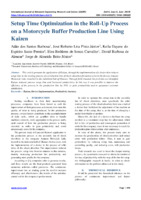 Setup Time Optimization in the Roll-Up Process on a Motorcycle Buffer Production Line Using Kaizen
Setup Time Optimization in the Roll-Up Process on a Motorcycle Buffer Production Line Using Kaizen Abstract— This article presents the application of Kaizen, through the implementation of a device that reduces
setup time in the routing process of a production line of shock absorbers for motorcycles in the factory Amazon
Motocicle Ltda, installed in the industrial hub of Manaus. Through field research the prob lem was identified.
Kaizen reduced process setup time and increased productivity. In this way it was possible to improve the
efficiency of the process in the production line by 50%, to gain productivity and to guarantee customer
satisfaction.
Keywords— Kaizen, Device Implementation, Productivity increase.
-
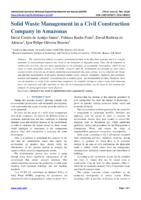 Solid Waste Management in a Civil Construction Company in Amazonas
Solid Waste Management in a Civil Construction Company in Amazonas Abstract— The construction industry occupies a prominent position in the Brazilian economy, but it is a major
generator of environmental impacts that result in the formation of degraded areas. Thus, the development of
construction activities that are more appropriate to the principles of sustainable construction, which do not
cause so many degrading actions, is inevitable. Concern with the environment has brought an alert where
various sectors of society are involved, promoting environmental education actions, so it is called for the strong
and effective participation of all agents involved (public sector, owners, companies, engineers and architects,
teachers and students, collectors’ associations) for a common good - the sustainability of cities. Therefore, there
was an initiative to verify if the construction companies are actually reusing to reduce waste and extracting
more raw materials and offer subsidies so that the environmental problem can be faced in this construction
company by giving appropriate waste disposal.
Keywords— About five key words in alphabetical order, separated by comma.
-
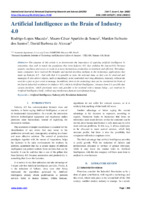 Artificial Intelligence as the Brain of Industry 4.0
Artificial Intelligence as the Brain of Industry 4.0 Abstract— The purpose of this article is to demonstrate the importance of applying artificial intelligence in
enterprises that seek to reach the paradigms that form Industry 4.0, thus unifying the interactivity between
systems, machines and assets to result in a more harmonious production environment and efficient. Nowadays,
many companies have realized the benefits and started investing millions in the technology applications that
make up Industry 4.0 . And with that it is possible to store the relevant data, so they can be analyzed and
managed. It also allows objects, such as machinery, to be controlled over long distances, remotely, without the
need for a face-to-face asset to manage. In addition, there is the technology that can be considered the brain of
the fourth industrial revolution (or Industry 4.0 ) which is Artificial Intelligence , because from it is possible that
certain decisions, which previously were only possible to be resolved with a human being , are resolved by
Artificial Intelligence itself , without any interference from an asset (human being).
Keywords— Artificial Intelligence; Industry 4.0; Revolution Industrial.
-
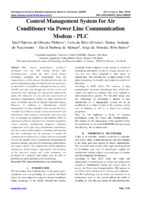 Control Management System for Air Conditioner via Power Line Communication Modem - PLC
Control Management System for Air Conditioner via Power Line Communication Modem - PLC Abstract—With several technological initiatives
developed with the PLC modem (Power Line
Communication), among the most varied themes
developed regarding the relationship from the
characteristics of the electric distribution networks, the
study in transmitting data through the electric network is
to show that it is possible to transmit the data in a fast,
reliable and safe way through the electric circuit well
structured, thus adjusting the connections between the
profit, the reduction of costs and the conservation of
preventive maintenance, mainly in what concerns the
reuse of electric network in already structured places.
However, in addition to implementing control
management, we have identified some reasons that have
not made it possible on a large scale as an alternative for
transmission with regard to interference and noise and
how we pointed out solutions to this problem. Thus, we
addressed technical characteristics between equipment,
circuit structure, multiplexing, frequency, technical
comparisons with other data transmission technologies
and an overview of the market, evaluating and showing
that this technology has the potential to enable the
communication of data in low-voltage electricity networks
to serve the specific school, meeting the requirements for
protocol transfer, especially for monitoring applications,
and rapid response. The explanations about definitions,
advantages, disadvantages, requirements, the interfaces
of the electrical system and other arguments, are
portrayed in a didactic and simple way, in order to
facilitate the understanding of this technology.
Keywords: PLC, data transmission, cost, monitoring
-
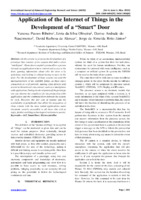 Application of the Internet of Things in the Development of a “Smart” Door
Application of the Internet of Things in the Development of a “Smart” Door Abstract—In this article we propose the development of a
prototype that consists of two systems that make a door
"intelligent". These door-coupled systems allow a person
through an application to have control and access to the
door, gaining information about who the door is by
unlocking and locking it without having to move to the
door. For the development of these systems was used the
microcontrollers of the esp8266 family, as these allow
connection to wi-fi network, making other devices with
access to this network can connect, such as a smartphone
with application. During the development of the prototype
one can observe the complexity for the production of the
application and the communication between the systems
by wi-fi. However, the low cost of systems and the
availability of peripherals that allow the integration of
these systems with the most varied applications, make
electronic security accessible to all those who wish to
enjoy, further enabling technological inclusion in society.
Keywords— IoT, Smart Door, Microcontroller.
-
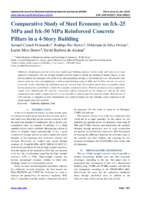 Comparative Study of Steel Economy on fck-25 MPa and fck-50 MPa Reinforced Concrete Pillars in a 4-Story Building
Comparative Study of Steel Economy on fck-25 MPa and fck-50 MPa Reinforced Concrete Pillars in a 4-Story Building Abstract— Reinforced concrete is the most widely used building typology in the world, with steel as its most
expensive component. The use of high strength concrete tends to enable the making of slender pieces, its use
directly implies the monetary cost of the work, thus generating savings or increasing the cost. The present work
aims to show the steel consumption for a dimensioned building using 25 MPa and 50 MPa concrete, as well as
to provide results regarding the utilization rates of concrete and steel sections and to draw conclusions about
the mechanical tests performed to obtain the strengths. mentioned above. With the mechanical tests satisfactory
results were obtained for the concrete consistency indexes measured by the slump test and by the axial
compression and tensile compression tests it was possible to demonstrate the expected results. With the use of
C50 concrete, a reduction in steel consumption was achieved mainly for the columns, when compared to the
design made using C25 concrete.
Keywords — Concrete, Software, Cost.
-
 Optimization of the Production Process Layout of a Small Clothing Company
Optimization of the Production Process Layout of a Small Clothing Company Abstract— Companies seek improvement of results through the use of process analysis tools. The aim of this study was to
analyze and structure the production process of a clothing manufacturing company, using methodologies such as PDCA and
quality tools that aided in decision making, proposing changes to optimize the main indicators of the feasibility of each
proposal with its cost-benefit.
Keywords— Process for making clothing, PDCA, Quality tools, Productivity indicator, Process layout.
-
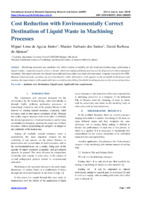 Cost Reduction with Environmentally Correct Destination of Liquid Waste in Machining Processes
Cost Reduction with Environmentally Correct Destination of Liquid Waste in Machining Processes Abstract—Machining processes use synthetic oils, either cutting or soluble, for the heavy processing stage, generating a
liquid residue, composed largely of heavy metals, which are highly polluting and can not be disposed of without adequate
treatment. This paper presents an already successful and successful case study of a renowned company located in the PIM -
Manaus industrial pole, pointing out an economically viable alternative, with support in the available technologies and
meeting the requirements of the applicable laws, as well as describing the whole learning process in the co urse of activities.
Keywords— Synthetic oils, Destination, Liquid waste, Applicable law requirements.
-
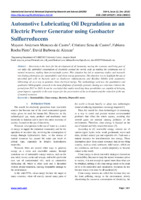 Automotive Lubricating Oil Degradation as an Electric Power Generator using Geobacter Sulfurreducens
Automotive Lubricating Oil Degradation as an Electric Power Generator using Geobacter Sulfurreducens Abstract— Electricity is the basis for the development of all humanity, moving the economy and being part of
our daily life, unbridled consumption of electricity around the world, ends up making the continuous use of
natural resources, making them increasingly scarce. This situation has led to numerous studies and research
into finding alternatives for sustainability and clean energy generation. The objective was to highlight the use of
microbial fuel cells in bacteria such as Geobacter sulfurreducens and Bacillus Subtilis with automotive
lubricating oil as a way to generate clean electrical energy. The methodology used was the quantitative and
qualitative bibliographic research in the main platforms of scientific journals, having as a selection criterion the
period from 2015 to 2019. It can be concluded that studies involving these possibilities are capable of bringing
great impacts, especially in the case respect for the preservation of the environment and the reduction of the use
of natural resources.
Keywords— Sustainability, Clean energy, Bacteria, Disposable waste.
-
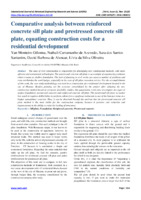 Comparative analysis between reinforced concrete sill plate and prestressed concrete sill plate, equating construction costs for a residential development
Comparative analysis between reinforced concrete sill plate and prestressed concrete sill plate, equating construction costs for a residential development Abstract— The area of civil construction is responsible for developing new construction methods, with more
efficient and economical technologies. The prestressed concrete sill plate is an example of engineering evolution
when it comes to shallow foundation. The lack of planning in civil works can cause a number of problems and
even overburden the work budget, especially in the case of sill plate execution service. For the accomplishment
of this work, the case study methodology was used in a construction of a residential development located in the
city of Manaus. Besides pointing out the economy consolidated by the project after adopting the new
construction method based on economic feasibility studies, this quantitative work aims to compare two types of
surface foundation: prestressed concrete and reinforced concrete sill plate. The prestressed sill plate, no matter
how much it requires skilled labor to perform, allows for a significant reduction in one of the heaviest items in a
budget spreadsheet: concrete. Thus, it can be observed through the analysis that the prestressed concrete sill
plate method is the most viable for the construction company because it presents cost reduction and
improvements in the ability to resist the loading of structures.
Keywords— Sill plate; Foundation; Reinforced concrete; Prestressed concrete.
-
 Effect of Cabrio® Top and Macuco Bean (Pachyrhizus spp.) Extracts on Soil Mesofauna
Effect of Cabrio® Top and Macuco Bean (Pachyrhizus spp.) Extracts on Soil Mesofauna Abstract— Macuco bean (Pachyrhizus spp.) Is an atypical horticulture that has toxicity in its seeds and has
potential for disease control, but its effect on soil stability is unknown? Among the bioindicators to evaluate soil
quality is the analysis of fauna diversity, considered to be the most sensitive for presenting rapid response to
changes. Therefore, the objective of this study was to determine the effect that macuco bean extracts and
Cabrio® Top fungicide have on the soil mesofauna, with a completely randomized block design with three
treatments and six replications. The treatments were: bean extract (1: 1000), a solution of Cabrio® Top (1: 250)
and the water control. Pipes 100 mm in diameter were inserted into the soil 10 cm deep, one pipe being the
experimental unit. For the extraction of mesofauna the Berlese-Tullgren method was used. After eight days in the
extractor the samples with the mesofauna were removed for proper counting on the stereoscope. Moisture, group
richness and abundance of individuals were evaluated. The results showed that soil moisture favored the
richness of the edaphic mesofauna. Extract and Cabrio® Top compared to water increased the richness of
faunal groups, but water presented higher abundance of specimens. However, all evaluated variables did not
show significant variability between treatments. Therefore, Macuco bean extract and Cabrio® Top maintained
soil quality without imbalancing the edaphic mesofauna.
Keywords— Collemboli, Mites; Group wealth; Abundance of specimens.
-
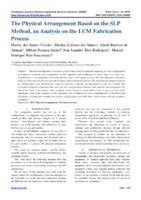 The Physical Arrangement Based on the SLP Method, an Analysis on the LCM Fabrication Process
The Physical Arrangement Based on the SLP Method, an Analysis on the LCM Fabrication Process Abstract— Physical arrangement or layout is a term widely used in corporate language, it is the configuration
of productive elements and transformers. In the industrial hub of Manaus in many cases it is either new
installations or rearrangements of deactivated line spaces. This paper aims to show the importance of Layout
study as well as its tools for process improvements and productivity increase. The methodology adopted is based
on bibliographic and documentary research (internal corporate documentation) using the method SLP
(systematic planning of Layout) that seeks the best configuration between: man, machine and equipment. The
aim of this work is to compare other academic works, books by great authors and to report a little of the
experience lived in the industry of the industrial pole of Manaus in lines of manufacture of Monito rs and
televisions, in particular introduction of lines of LCD panels and LED, thus collaborating with the academic
community.
Keywords— SLP, Physical Arrangement, Television screens
-
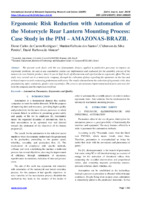 Ergonomic Risk Reduction with Automation of the Motorcycle Rear Lantern Mounting Process: Case Study in the PIM – AMAZONAS-BRAZIL
Ergonomic Risk Reduction with Automation of the Motorcycle Rear Lantern Mounting Process: Case Study in the PIM – AMAZONAS-BRAZIL Abstract— The present work deals with the use of pneumatic devices, applied in productive processes to improve an
ergonomic problem. An easy-to-use automation system was implemented and evaluated for the assembly process of the
motorcycle rear lantern product, since it was in high levels of absenteeism and rejection due to ergonomic effort. The case
study was carried out in a motorcycle company, through the collection of data regarding the operation on the line and
technical report records containing performance indicators. The results obtained were the reduction of ergonomic risks, thus
guaranteeing safety standards, quality and ergonomics. The process of continuous improvement and of great relevance for
both the company and the employees involved.
Keywords— Automation, Pneumatics, Ergonomics and Quality.
-
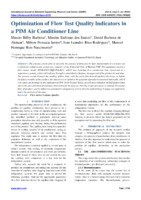 Optimization of Flow Test Quality Indicators in a PIM Air Conditioner Line
Optimization of Flow Test Quality Indicators in a PIM Air Conditioner Line Abstract— The present article aims to describe the process of detection by flow measurement in a window air
conditioner refrigeration system of a company of the Industrial Pole of Manaus PIM. The equipment used is a
flow sensor model SFAB-200U-HQ8-2SA-M12, which was installed in a production line, connected to a
supervisory system, which will indicate through a visual device Andons, the approval of the product in real time .
The process occurs through the sending of flow data, with the early detection of capillary blockage, ie, before
the final assembly of the product, the objective is to optimize the quantity of products reworked internally, which
will cause an increase in the indicator of FPY (First Passed Yield), as well as a reduction in field failure rates
due to the non-detection of capillary obstruction in the process. For this, it was necessary to identify the normal
flow of product, and to define new parameters of approval, next to this the methodology 6 sigma was applied to
make the analysis of the data.
Keywords— Flow meter; 6 sigma; Quality.
-
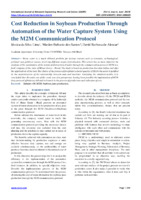 Cost Reduction in Soybean Production Through Automation of the Water Capture System Using the M2M Communication Protocol
Cost Reduction in Soybean Production Through Automation of the Water Capture System Using the M2M Communication Protocol Abstract— Waste water is a much debated problem, for various reasons such as economic, technological,
political and political causes, involving different stages of production. This article has as main objective the
analysis of the automation of the system of abstraction of water through the communication protocol M2M in a
food company of the state of Minas Gerais - Brazil. The study is based on production line data before and after
the application of the tool. The choice of the process of propitiate a better quality of life for the users is justified
by the modernization of the relationship between man and machine. Analyzing the obtained results, it is
concluded that the main one of the work was also prosperous, having been possible the implantation of M2M
data protocol of Industry 4.0 and its branch in the process of production and reduction of cost .
Keywords— Industry 4.0, M2M, Soybean juice production.
-
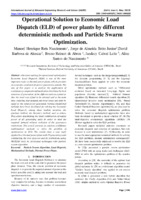 Operational Solution to Economic Load Dispatch (ELD) of power plants by different deterministic methods and Particle Swarm Optimization.
Operational Solution to Economic Load Dispatch (ELD) of power plants by different deterministic methods and Particle Swarm Optimization. Abstract—Decision-making for operational optimization
Economic Load Dispatch (ELD) is one of the most
important tasks in thermal power plants, which provides
an economic condition for power generation systems. The
aim of this paper is to analyze the application of
evolutionary computational methods to determine the best
situation of generation of the different units in a plant so
that the total cost of fuel to be minimal and at the same
time, ensuring that demand and total losses any time be
equal to the total power generated. Various traditional
methods have been developed for solving the Economic
Load Dispatch, among them: lambda iteration, the
gradient method, the Newton's method, and so others.
They allow determining the ideal combination of output
power of all generating units in order to meet the
required demand without violation of the generators
restrictions. This article presents an analysis of different
mathematical methods to solve the problem of
optimization in ELD. The results show a case study
applied in a thermal power plant with 10 generating units
considering the loss of power and its restrictions, using
MATLAB tools by developed techniques with particle
swarm algorithm.
Keywords —Particle Swarm Algorithm, Load Di
-
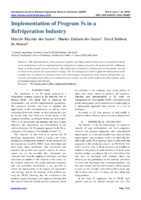 Implementation of Program 5s in a Refrigeration Industry
Implementation of Program 5s in a Refrigeration Industry Abstract— The implementation of the program of quality and improvement in the process of production based
on the methodology in 5S was implemented in a refrigeration company located in the Industrial Pole of Manaus,
based on bibliographic research in books. This philosophy is intended to inform and train the people who are
involved in the process of organizational change. The 5S technique was used to apply the improvement in the
assembly line, in relation to cleaning in the work environment, organization of the utensils of immediate use,
creation and demarcation of layout to attend the process flow, as well as the verification of the lighting of the
environment among other factors.
Keywords— 5S, Layout, process flow, refrigeration industry.
-
 Survey of Environmental Quality in Three Springs of an Integral Protection Conservation Unit in Manaus-Amazonas
Survey of Environmental Quality in Three Springs of an Integral Protection Conservation Unit in Manaus-Amazonas Abstract— Springs are characterized as groundwater environmental hydro systems, in which they occur
temporarily or perennially, and are present in natural and anthropic areas. The present study analyzed the
environmental quality in three springs located in an integral protection conservation unit in the city of Manaus,
Amazonas. To characterize the study area, there was georeferencing of images from the Google Earth software
in the ArcGIS and Qgis programs, the survey of the environmental quality of the springs was performed through
the methodological procedure of macroscopic analysis of 12 physicochemical and biological parameters and,
the classification of spring conditions by the sum of the degree of criticality of each item evaluated, resulting in a
score. It was verified that two springs were classified as “bad” and “bad”, respectively, and only one spring
was rated “optimal” for its environmental condition, due to its degree of distance from the urbanization limit.
The results revealed a warning sign regarding the neglect of the environmental agencies regarding the
protection of existing natural resources, consequently, indicate the need to carry out an inspection regarding
compliance with the established laws for the preservation of water bodies and riparian forests.
Keywords— Hydro systems; Environmental Quality; Environmental impacts; natural resources; water
bodies.
-
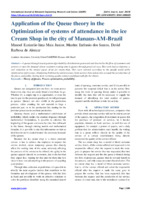 Application of the Queue theory in the Optimization of systems of attendance in the ice Cream Shop in the city of Manaus-AM-Brazil
Application of the Queue theory in the Optimization of systems of attendance in the ice Cream Shop in the city of Manaus-AM-Brazil Abstract— A queues through investigations of probability distributions generated and directed to the flow of customers and
services to meet the demand of new customers waiting time in queues through practical ways. This work had as objective, a
real reduction in the service queue of an ice cream shop. They were selected according to the specific needs of the
optimization of processes, eliminating bottlenecks and processes. Some services have taken into account the peculiarities of
the place, and public, having been receiving quality services and financially for the clients.
Keywords— Theory of Queues, Process optimization, probability.
-
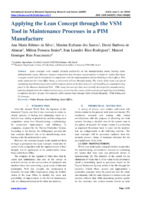 Applying the Lean Concept through the VSM Tool in Maintenance Processes in a PIM Manufacture
Applying the Lean Concept through the VSM Tool in Maintenance Processes in a PIM Manufacture Abstract— Lean concepts were usually focused exclusively on the manufacturing areas, leaving aside
administrative areas. However intense competition has led many organizations to begin to realize that these
concepts would also be beneficial to competition with the implementation of lean thinking in their offices. This
study addresses the Lean Office theme, a derivation of Lean Manufacturing. The vision of the Lean con cept of
identifying and eliminating wastes enables improvements in the flow of service call handling at a manufacturing
plant in the Manaus Industrial Pole - PIM, using the concepts that were initially developed for manufacturing,
making adaptations to the administrative areas, preserving the essence of the concept and applying lean thinking
to improve the flow of care. For analysis of the current state through Value Stream Mapping -VSM, timing and
5S Concept.
Keywords— Value Stream, Lean Thinking, Lean Office
-
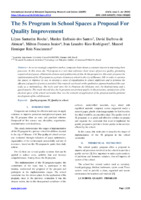 The 5s Program in School Spaces a Proposal For Quality Improvement
The 5s Program in School Spaces a Proposal For Quality Improvement Abstract— In an increasingly competitive market, companies have shown a constant interest in improving their
processes. In this sense, the 5S program is a tool that addresses these issues of pro cess quality, promoting
organization of spaces, elimination of waste and optimization of time. In this perspective, this study proposes the
implementation of the 5S program in a private elementary school in the city of Manaus-AM, in order to optimize
the spaces to improve its use, to develop a sense of organization in school employees and to promote the
efficiency of quality of services provided. This research was based on the qualitative approach and used the case
study as a methodology. The tools used were the 5s Program, the Ishikawa tool, the Brainstorming and a
questionnaire. The result showed that the 5s program can promote quality in the processes, optimization of the
physical space of the school secretariat that was the scenario of application of the program and the personal
development of the collaborators.
Keywords— Quality program, 5S, Quality in school.
-
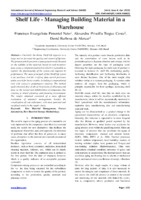 Shelf Life - Managing Building Material in a Warehouse
Shelf Life - Managing Building Material in a Warehouse Abstract— Currently the theme Shelf Life appears as a
large tool to increase the quality and control of life time.
The present article presents a management model focused
on the validity of the material, based on real inventory
data, using a computational tool in which it is possible to
explore the functionality of the system and improve its
performance. The main principal of this Shelf Life system
is an auxiliary tool for verifying data search processes
and a search for better results, including a computational
tool with extensive performance analysis. The method
used consisted, first of all, of the process of obtaining real
data on the receipt and indebtedness of companies, thus
creating a virtual planning and planning environment.
The results obtained consisted of a more efficient
evaluation of materials management, besides the
visualization of cost reductions, with more punctual and
weighted results in the supply chain.
Keywords— Raw Material Management, Process
Automation, Raw Material Storage Methodology.
-
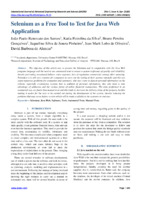 Selenium as a Free Tool to Test for Java Web Application
Selenium as a Free Tool to Test for Java Web Application Abstract— The objective of this article was to present the Selenium tool in conjunction with the Java Web
program language and the need to use automated tests to ensure a system (software) of quality and reliability,
thereby preventing occasional failures, extra expenses, loss of reputation commercial, among other annoying.
Nowadays it is still very common for companies to carry out the testing of their systems manually and this can
cause numerous problems for companies and customers, who may come to deposit personal information on the
website, especially e-commerce systems that in addition of personal information, they also tend to take
advantage of addresses and the various forms of online financial transactions. The tests performed in an
automated way are faster than manual tests and this tends to decrease the delivery delay of the projects, besides
making it easier for the tests to be carried out during the development of the system, thereby reducing the
problems that may occur before version which will be made available to the customer or end user.
Keywords— Selenium; Java Web; Software; Tests; Automated Tests; Manual Tests
-
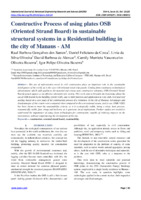 Constructive Process of using plates OSB (Oriented Strand Board) in sustainable structural systems in a Residential building in the city of Manaus - AM
Constructive Process of using plates OSB (Oriented Strand Board) in sustainable structural systems in a Residential building in the city of Manaus - AM Abstract— The use of reforestation wood in civil construction plays an important role in the sustainable
development of the world, as is the case with oriented wood strip panels. Coming from continuous technological
advancement, which adds quality to the material and creates new constructive solutions, OSB (Oriented Strand
Board) panels appear as an effective alternative for society. This work aims to broaden the knowledge about the
use of OSB boards in the building system (CES), due to their function and application in wall, slab, roof and roof
sealing, based on a case study of the construction process of a residence. in the city of Manaus. Advantages and
disadvantages of this system were compared when compared to the conventional system, and its use (OSB / CES)
has been shown to meet the sustainability criteria, as it is ecologically viable, being a clean, lean process;
economically viable, fast, cheap and inclusive as it generates local employment. Further studies are needed to
understand the importance of using clean technologies for construction, capable of reducing impacts on the
environment, without compromising the development of the site.
Keywords— construction, oriented strand board, sustainability
-
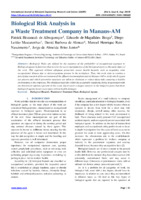 Biological Risk Analysis in a Waste Treatment Company in Manaus-AM
Biological Risk Analysis in a Waste Treatment Company in Manaus-AM Abstract— Biological Risks are defined by the existence of the probability of occupational exposure to
Biological agents in functions that involve the use or manipulation of the biological agent as the main object of
the work. This exposure without adequate protection causes health hazards, such as acquiring some
occupational disease due to microorganisms present in the workplace. Thus, this work aims to conduct a
descriptive research of the environment of the effluent treatment plant unit in Manaus-AM to verify which agents
are present and which preventive measures are taken to eliminate or reduce these risks, ensuring a healthy
environment. to the employee. The obtained result fits within the acceptable standards, being in agreement with
the theoretical reference present in this work, but it needs a deeper analysis in the subject to prove that these
biological agents do not cause more serious health damages.
Keywords— Biological Hazards, Wastewater Treatment Plant, Biological Agents
 Setup Time Optimization in the Roll-Up Process on a Motorcycle Buffer Production Line Using Kaizen Abstract— This article presents the application of Kaizen, through the implementation of a device that reduces setup time in the routing process of a production line of shock absorbers for motorcycles in the factory Amazon Motocicle Ltda, installed in the industrial hub of Manaus. Through field research the prob lem was identified. Kaizen reduced process setup time and increased productivity. In this way it was possible to improve the efficiency of the process in the production line by 50%, to gain productivity and to guarantee customer satisfaction. Keywords— Kaizen, Device Implementation, Productivity increase.
Setup Time Optimization in the Roll-Up Process on a Motorcycle Buffer Production Line Using Kaizen Abstract— This article presents the application of Kaizen, through the implementation of a device that reduces setup time in the routing process of a production line of shock absorbers for motorcycles in the factory Amazon Motocicle Ltda, installed in the industrial hub of Manaus. Through field research the prob lem was identified. Kaizen reduced process setup time and increased productivity. In this way it was possible to improve the efficiency of the process in the production line by 50%, to gain productivity and to guarantee customer satisfaction. Keywords— Kaizen, Device Implementation, Productivity increase. Solid Waste Management in a Civil Construction Company in Amazonas Abstract— The construction industry occupies a prominent position in the Brazilian economy, but it is a major generator of environmental impacts that result in the formation of degraded areas. Thus, the development of construction activities that are more appropriate to the principles of sustainable construction, which do not cause so many degrading actions, is inevitable. Concern with the environment has brought an alert where various sectors of society are involved, promoting environmental education actions, so it is called for the strong and effective participation of all agents involved (public sector, owners, companies, engineers and architects, teachers and students, collectors’ associations) for a common good - the sustainability of cities. Therefore, there was an initiative to verify if the construction companies are actually reusing to reduce waste and extracting more raw materials and offer subsidies so that the environmental problem can be faced in this construction company by giving appropriate waste disposal. Keywords— About five key words in alphabetical order, separated by comma.
Solid Waste Management in a Civil Construction Company in Amazonas Abstract— The construction industry occupies a prominent position in the Brazilian economy, but it is a major generator of environmental impacts that result in the formation of degraded areas. Thus, the development of construction activities that are more appropriate to the principles of sustainable construction, which do not cause so many degrading actions, is inevitable. Concern with the environment has brought an alert where various sectors of society are involved, promoting environmental education actions, so it is called for the strong and effective participation of all agents involved (public sector, owners, companies, engineers and architects, teachers and students, collectors’ associations) for a common good - the sustainability of cities. Therefore, there was an initiative to verify if the construction companies are actually reusing to reduce waste and extracting more raw materials and offer subsidies so that the environmental problem can be faced in this construction company by giving appropriate waste disposal. Keywords— About five key words in alphabetical order, separated by comma. Artificial Intelligence as the Brain of Industry 4.0 Abstract— The purpose of this article is to demonstrate the importance of applying artificial intelligence in enterprises that seek to reach the paradigms that form Industry 4.0, thus unifying the interactivity between systems, machines and assets to result in a more harmonious production environment and efficient. Nowadays, many companies have realized the benefits and started investing millions in the technology applications that make up Industry 4.0 . And with that it is possible to store the relevant data, so they can be analyzed and managed. It also allows objects, such as machinery, to be controlled over long distances, remotely, without the need for a face-to-face asset to manage. In addition, there is the technology that can be considered the brain of the fourth industrial revolution (or Industry 4.0 ) which is Artificial Intelligence , because from it is possible that certain decisions, which previously were only possible to be resolved with a human being , are resolved by Artificial Intelligence itself , without any interference from an asset (human being). Keywords— Artificial Intelligence; Industry 4.0; Revolution Industrial.
Artificial Intelligence as the Brain of Industry 4.0 Abstract— The purpose of this article is to demonstrate the importance of applying artificial intelligence in enterprises that seek to reach the paradigms that form Industry 4.0, thus unifying the interactivity between systems, machines and assets to result in a more harmonious production environment and efficient. Nowadays, many companies have realized the benefits and started investing millions in the technology applications that make up Industry 4.0 . And with that it is possible to store the relevant data, so they can be analyzed and managed. It also allows objects, such as machinery, to be controlled over long distances, remotely, without the need for a face-to-face asset to manage. In addition, there is the technology that can be considered the brain of the fourth industrial revolution (or Industry 4.0 ) which is Artificial Intelligence , because from it is possible that certain decisions, which previously were only possible to be resolved with a human being , are resolved by Artificial Intelligence itself , without any interference from an asset (human being). Keywords— Artificial Intelligence; Industry 4.0; Revolution Industrial. Control Management System for Air Conditioner via Power Line Communication Modem - PLC Abstract—With several technological initiatives developed with the PLC modem (Power Line Communication), among the most varied themes developed regarding the relationship from the characteristics of the electric distribution networks, the study in transmitting data through the electric network is to show that it is possible to transmit the data in a fast, reliable and safe way through the electric circuit well structured, thus adjusting the connections between the profit, the reduction of costs and the conservation of preventive maintenance, mainly in what concerns the reuse of electric network in already structured places. However, in addition to implementing control management, we have identified some reasons that have not made it possible on a large scale as an alternative for transmission with regard to interference and noise and how we pointed out solutions to this problem. Thus, we addressed technical characteristics between equipment, circuit structure, multiplexing, frequency, technical comparisons with other data transmission technologies and an overview of the market, evaluating and showing that this technology has the potential to enable the communication of data in low-voltage electricity networks to serve the specific school, meeting the requirements for protocol transfer, especially for monitoring applications, and rapid response. The explanations about definitions, advantages, disadvantages, requirements, the interfaces of the electrical system and other arguments, are portrayed in a didactic and simple way, in order to facilitate the understanding of this technology. Keywords: PLC, data transmission, cost, monitoring
Control Management System for Air Conditioner via Power Line Communication Modem - PLC Abstract—With several technological initiatives developed with the PLC modem (Power Line Communication), among the most varied themes developed regarding the relationship from the characteristics of the electric distribution networks, the study in transmitting data through the electric network is to show that it is possible to transmit the data in a fast, reliable and safe way through the electric circuit well structured, thus adjusting the connections between the profit, the reduction of costs and the conservation of preventive maintenance, mainly in what concerns the reuse of electric network in already structured places. However, in addition to implementing control management, we have identified some reasons that have not made it possible on a large scale as an alternative for transmission with regard to interference and noise and how we pointed out solutions to this problem. Thus, we addressed technical characteristics between equipment, circuit structure, multiplexing, frequency, technical comparisons with other data transmission technologies and an overview of the market, evaluating and showing that this technology has the potential to enable the communication of data in low-voltage electricity networks to serve the specific school, meeting the requirements for protocol transfer, especially for monitoring applications, and rapid response. The explanations about definitions, advantages, disadvantages, requirements, the interfaces of the electrical system and other arguments, are portrayed in a didactic and simple way, in order to facilitate the understanding of this technology. Keywords: PLC, data transmission, cost, monitoring Application of the Internet of Things in the Development of a “Smart” Door Abstract—In this article we propose the development of a prototype that consists of two systems that make a door "intelligent". These door-coupled systems allow a person through an application to have control and access to the door, gaining information about who the door is by unlocking and locking it without having to move to the door. For the development of these systems was used the microcontrollers of the esp8266 family, as these allow connection to wi-fi network, making other devices with access to this network can connect, such as a smartphone with application. During the development of the prototype one can observe the complexity for the production of the application and the communication between the systems by wi-fi. However, the low cost of systems and the availability of peripherals that allow the integration of these systems with the most varied applications, make electronic security accessible to all those who wish to enjoy, further enabling technological inclusion in society. Keywords— IoT, Smart Door, Microcontroller.
Application of the Internet of Things in the Development of a “Smart” Door Abstract—In this article we propose the development of a prototype that consists of two systems that make a door "intelligent". These door-coupled systems allow a person through an application to have control and access to the door, gaining information about who the door is by unlocking and locking it without having to move to the door. For the development of these systems was used the microcontrollers of the esp8266 family, as these allow connection to wi-fi network, making other devices with access to this network can connect, such as a smartphone with application. During the development of the prototype one can observe the complexity for the production of the application and the communication between the systems by wi-fi. However, the low cost of systems and the availability of peripherals that allow the integration of these systems with the most varied applications, make electronic security accessible to all those who wish to enjoy, further enabling technological inclusion in society. Keywords— IoT, Smart Door, Microcontroller. Comparative Study of Steel Economy on fck-25 MPa and fck-50 MPa Reinforced Concrete Pillars in a 4-Story Building Abstract— Reinforced concrete is the most widely used building typology in the world, with steel as its most expensive component. The use of high strength concrete tends to enable the making of slender pieces, its use directly implies the monetary cost of the work, thus generating savings or increasing the cost. The present work aims to show the steel consumption for a dimensioned building using 25 MPa and 50 MPa concrete, as well as to provide results regarding the utilization rates of concrete and steel sections and to draw conclusions about the mechanical tests performed to obtain the strengths. mentioned above. With the mechanical tests satisfactory results were obtained for the concrete consistency indexes measured by the slump test and by the axial compression and tensile compression tests it was possible to demonstrate the expected results. With the use of C50 concrete, a reduction in steel consumption was achieved mainly for the columns, when compared to the design made using C25 concrete. Keywords — Concrete, Software, Cost.
Comparative Study of Steel Economy on fck-25 MPa and fck-50 MPa Reinforced Concrete Pillars in a 4-Story Building Abstract— Reinforced concrete is the most widely used building typology in the world, with steel as its most expensive component. The use of high strength concrete tends to enable the making of slender pieces, its use directly implies the monetary cost of the work, thus generating savings or increasing the cost. The present work aims to show the steel consumption for a dimensioned building using 25 MPa and 50 MPa concrete, as well as to provide results regarding the utilization rates of concrete and steel sections and to draw conclusions about the mechanical tests performed to obtain the strengths. mentioned above. With the mechanical tests satisfactory results were obtained for the concrete consistency indexes measured by the slump test and by the axial compression and tensile compression tests it was possible to demonstrate the expected results. With the use of C50 concrete, a reduction in steel consumption was achieved mainly for the columns, when compared to the design made using C25 concrete. Keywords — Concrete, Software, Cost. Optimization of the Production Process Layout of a Small Clothing Company Abstract— Companies seek improvement of results through the use of process analysis tools. The aim of this study was to analyze and structure the production process of a clothing manufacturing company, using methodologies such as PDCA and quality tools that aided in decision making, proposing changes to optimize the main indicators of the feasibility of each proposal with its cost-benefit. Keywords— Process for making clothing, PDCA, Quality tools, Productivity indicator, Process layout.
Optimization of the Production Process Layout of a Small Clothing Company Abstract— Companies seek improvement of results through the use of process analysis tools. The aim of this study was to analyze and structure the production process of a clothing manufacturing company, using methodologies such as PDCA and quality tools that aided in decision making, proposing changes to optimize the main indicators of the feasibility of each proposal with its cost-benefit. Keywords— Process for making clothing, PDCA, Quality tools, Productivity indicator, Process layout. Cost Reduction with Environmentally Correct Destination of Liquid Waste in Machining Processes Abstract—Machining processes use synthetic oils, either cutting or soluble, for the heavy processing stage, generating a liquid residue, composed largely of heavy metals, which are highly polluting and can not be disposed of without adequate treatment. This paper presents an already successful and successful case study of a renowned company located in the PIM - Manaus industrial pole, pointing out an economically viable alternative, with support in the available technologies and meeting the requirements of the applicable laws, as well as describing the whole learning process in the co urse of activities. Keywords— Synthetic oils, Destination, Liquid waste, Applicable law requirements.
Cost Reduction with Environmentally Correct Destination of Liquid Waste in Machining Processes Abstract—Machining processes use synthetic oils, either cutting or soluble, for the heavy processing stage, generating a liquid residue, composed largely of heavy metals, which are highly polluting and can not be disposed of without adequate treatment. This paper presents an already successful and successful case study of a renowned company located in the PIM - Manaus industrial pole, pointing out an economically viable alternative, with support in the available technologies and meeting the requirements of the applicable laws, as well as describing the whole learning process in the co urse of activities. Keywords— Synthetic oils, Destination, Liquid waste, Applicable law requirements. Automotive Lubricating Oil Degradation as an Electric Power Generator using Geobacter Sulfurreducens Abstract— Electricity is the basis for the development of all humanity, moving the economy and being part of our daily life, unbridled consumption of electricity around the world, ends up making the continuous use of natural resources, making them increasingly scarce. This situation has led to numerous studies and research into finding alternatives for sustainability and clean energy generation. The objective was to highlight the use of microbial fuel cells in bacteria such as Geobacter sulfurreducens and Bacillus Subtilis with automotive lubricating oil as a way to generate clean electrical energy. The methodology used was the quantitative and qualitative bibliographic research in the main platforms of scientific journals, having as a selection criterion the period from 2015 to 2019. It can be concluded that studies involving these possibilities are capable of bringing great impacts, especially in the case respect for the preservation of the environment and the reduction of the use of natural resources. Keywords— Sustainability, Clean energy, Bacteria, Disposable waste.
Automotive Lubricating Oil Degradation as an Electric Power Generator using Geobacter Sulfurreducens Abstract— Electricity is the basis for the development of all humanity, moving the economy and being part of our daily life, unbridled consumption of electricity around the world, ends up making the continuous use of natural resources, making them increasingly scarce. This situation has led to numerous studies and research into finding alternatives for sustainability and clean energy generation. The objective was to highlight the use of microbial fuel cells in bacteria such as Geobacter sulfurreducens and Bacillus Subtilis with automotive lubricating oil as a way to generate clean electrical energy. The methodology used was the quantitative and qualitative bibliographic research in the main platforms of scientific journals, having as a selection criterion the period from 2015 to 2019. It can be concluded that studies involving these possibilities are capable of bringing great impacts, especially in the case respect for the preservation of the environment and the reduction of the use of natural resources. Keywords— Sustainability, Clean energy, Bacteria, Disposable waste. Comparative analysis between reinforced concrete sill plate and prestressed concrete sill plate, equating construction costs for a residential development Abstract— The area of civil construction is responsible for developing new construction methods, with more efficient and economical technologies. The prestressed concrete sill plate is an example of engineering evolution when it comes to shallow foundation. The lack of planning in civil works can cause a number of problems and even overburden the work budget, especially in the case of sill plate execution service. For the accomplishment of this work, the case study methodology was used in a construction of a residential development located in the city of Manaus. Besides pointing out the economy consolidated by the project after adopting the new construction method based on economic feasibility studies, this quantitative work aims to compare two types of surface foundation: prestressed concrete and reinforced concrete sill plate. The prestressed sill plate, no matter how much it requires skilled labor to perform, allows for a significant reduction in one of the heaviest items in a budget spreadsheet: concrete. Thus, it can be observed through the analysis that the prestressed concrete sill plate method is the most viable for the construction company because it presents cost reduction and improvements in the ability to resist the loading of structures. Keywords— Sill plate; Foundation; Reinforced concrete; Prestressed concrete.
Comparative analysis between reinforced concrete sill plate and prestressed concrete sill plate, equating construction costs for a residential development Abstract— The area of civil construction is responsible for developing new construction methods, with more efficient and economical technologies. The prestressed concrete sill plate is an example of engineering evolution when it comes to shallow foundation. The lack of planning in civil works can cause a number of problems and even overburden the work budget, especially in the case of sill plate execution service. For the accomplishment of this work, the case study methodology was used in a construction of a residential development located in the city of Manaus. Besides pointing out the economy consolidated by the project after adopting the new construction method based on economic feasibility studies, this quantitative work aims to compare two types of surface foundation: prestressed concrete and reinforced concrete sill plate. The prestressed sill plate, no matter how much it requires skilled labor to perform, allows for a significant reduction in one of the heaviest items in a budget spreadsheet: concrete. Thus, it can be observed through the analysis that the prestressed concrete sill plate method is the most viable for the construction company because it presents cost reduction and improvements in the ability to resist the loading of structures. Keywords— Sill plate; Foundation; Reinforced concrete; Prestressed concrete. Effect of Cabrio® Top and Macuco Bean (Pachyrhizus spp.) Extracts on Soil Mesofauna Abstract— Macuco bean (Pachyrhizus spp.) Is an atypical horticulture that has toxicity in its seeds and has potential for disease control, but its effect on soil stability is unknown? Among the bioindicators to evaluate soil quality is the analysis of fauna diversity, considered to be the most sensitive for presenting rapid response to changes. Therefore, the objective of this study was to determine the effect that macuco bean extracts and Cabrio® Top fungicide have on the soil mesofauna, with a completely randomized block design with three treatments and six replications. The treatments were: bean extract (1: 1000), a solution of Cabrio® Top (1: 250) and the water control. Pipes 100 mm in diameter were inserted into the soil 10 cm deep, one pipe being the experimental unit. For the extraction of mesofauna the Berlese-Tullgren method was used. After eight days in the extractor the samples with the mesofauna were removed for proper counting on the stereoscope. Moisture, group richness and abundance of individuals were evaluated. The results showed that soil moisture favored the richness of the edaphic mesofauna. Extract and Cabrio® Top compared to water increased the richness of faunal groups, but water presented higher abundance of specimens. However, all evaluated variables did not show significant variability between treatments. Therefore, Macuco bean extract and Cabrio® Top maintained soil quality without imbalancing the edaphic mesofauna. Keywords— Collemboli, Mites; Group wealth; Abundance of specimens.
Effect of Cabrio® Top and Macuco Bean (Pachyrhizus spp.) Extracts on Soil Mesofauna Abstract— Macuco bean (Pachyrhizus spp.) Is an atypical horticulture that has toxicity in its seeds and has potential for disease control, but its effect on soil stability is unknown? Among the bioindicators to evaluate soil quality is the analysis of fauna diversity, considered to be the most sensitive for presenting rapid response to changes. Therefore, the objective of this study was to determine the effect that macuco bean extracts and Cabrio® Top fungicide have on the soil mesofauna, with a completely randomized block design with three treatments and six replications. The treatments were: bean extract (1: 1000), a solution of Cabrio® Top (1: 250) and the water control. Pipes 100 mm in diameter were inserted into the soil 10 cm deep, one pipe being the experimental unit. For the extraction of mesofauna the Berlese-Tullgren method was used. After eight days in the extractor the samples with the mesofauna were removed for proper counting on the stereoscope. Moisture, group richness and abundance of individuals were evaluated. The results showed that soil moisture favored the richness of the edaphic mesofauna. Extract and Cabrio® Top compared to water increased the richness of faunal groups, but water presented higher abundance of specimens. However, all evaluated variables did not show significant variability between treatments. Therefore, Macuco bean extract and Cabrio® Top maintained soil quality without imbalancing the edaphic mesofauna. Keywords— Collemboli, Mites; Group wealth; Abundance of specimens. The Physical Arrangement Based on the SLP Method, an Analysis on the LCM Fabrication Process Abstract— Physical arrangement or layout is a term widely used in corporate language, it is the configuration of productive elements and transformers. In the industrial hub of Manaus in many cases it is either new installations or rearrangements of deactivated line spaces. This paper aims to show the importance of Layout study as well as its tools for process improvements and productivity increase. The methodology adopted is based on bibliographic and documentary research (internal corporate documentation) using the method SLP (systematic planning of Layout) that seeks the best configuration between: man, machine and equipment. The aim of this work is to compare other academic works, books by great authors and to report a little of the experience lived in the industry of the industrial pole of Manaus in lines of manufacture of Monito rs and televisions, in particular introduction of lines of LCD panels and LED, thus collaborating with the academic community. Keywords— SLP, Physical Arrangement, Television screens
The Physical Arrangement Based on the SLP Method, an Analysis on the LCM Fabrication Process Abstract— Physical arrangement or layout is a term widely used in corporate language, it is the configuration of productive elements and transformers. In the industrial hub of Manaus in many cases it is either new installations or rearrangements of deactivated line spaces. This paper aims to show the importance of Layout study as well as its tools for process improvements and productivity increase. The methodology adopted is based on bibliographic and documentary research (internal corporate documentation) using the method SLP (systematic planning of Layout) that seeks the best configuration between: man, machine and equipment. The aim of this work is to compare other academic works, books by great authors and to report a little of the experience lived in the industry of the industrial pole of Manaus in lines of manufacture of Monito rs and televisions, in particular introduction of lines of LCD panels and LED, thus collaborating with the academic community. Keywords— SLP, Physical Arrangement, Television screens Ergonomic Risk Reduction with Automation of the Motorcycle Rear Lantern Mounting Process: Case Study in the PIM – AMAZONAS-BRAZIL Abstract— The present work deals with the use of pneumatic devices, applied in productive processes to improve an ergonomic problem. An easy-to-use automation system was implemented and evaluated for the assembly process of the motorcycle rear lantern product, since it was in high levels of absenteeism and rejection due to ergonomic effort. The case study was carried out in a motorcycle company, through the collection of data regarding the operation on the line and technical report records containing performance indicators. The results obtained were the reduction of ergonomic risks, thus guaranteeing safety standards, quality and ergonomics. The process of continuous improvement and of great relevance for both the company and the employees involved. Keywords— Automation, Pneumatics, Ergonomics and Quality.
Ergonomic Risk Reduction with Automation of the Motorcycle Rear Lantern Mounting Process: Case Study in the PIM – AMAZONAS-BRAZIL Abstract— The present work deals with the use of pneumatic devices, applied in productive processes to improve an ergonomic problem. An easy-to-use automation system was implemented and evaluated for the assembly process of the motorcycle rear lantern product, since it was in high levels of absenteeism and rejection due to ergonomic effort. The case study was carried out in a motorcycle company, through the collection of data regarding the operation on the line and technical report records containing performance indicators. The results obtained were the reduction of ergonomic risks, thus guaranteeing safety standards, quality and ergonomics. The process of continuous improvement and of great relevance for both the company and the employees involved. Keywords— Automation, Pneumatics, Ergonomics and Quality. Optimization of Flow Test Quality Indicators in a PIM Air Conditioner Line Abstract— The present article aims to describe the process of detection by flow measurement in a window air conditioner refrigeration system of a company of the Industrial Pole of Manaus PIM. The equipment used is a flow sensor model SFAB-200U-HQ8-2SA-M12, which was installed in a production line, connected to a supervisory system, which will indicate through a visual device Andons, the approval of the product in real time . The process occurs through the sending of flow data, with the early detection of capillary blockage, ie, before the final assembly of the product, the objective is to optimize the quantity of products reworked internally, which will cause an increase in the indicator of FPY (First Passed Yield), as well as a reduction in field failure rates due to the non-detection of capillary obstruction in the process. For this, it was necessary to identify the normal flow of product, and to define new parameters of approval, next to this the methodology 6 sigma was applied to make the analysis of the data. Keywords— Flow meter; 6 sigma; Quality.
Optimization of Flow Test Quality Indicators in a PIM Air Conditioner Line Abstract— The present article aims to describe the process of detection by flow measurement in a window air conditioner refrigeration system of a company of the Industrial Pole of Manaus PIM. The equipment used is a flow sensor model SFAB-200U-HQ8-2SA-M12, which was installed in a production line, connected to a supervisory system, which will indicate through a visual device Andons, the approval of the product in real time . The process occurs through the sending of flow data, with the early detection of capillary blockage, ie, before the final assembly of the product, the objective is to optimize the quantity of products reworked internally, which will cause an increase in the indicator of FPY (First Passed Yield), as well as a reduction in field failure rates due to the non-detection of capillary obstruction in the process. For this, it was necessary to identify the normal flow of product, and to define new parameters of approval, next to this the methodology 6 sigma was applied to make the analysis of the data. Keywords— Flow meter; 6 sigma; Quality. Cost Reduction in Soybean Production Through Automation of the Water Capture System Using the M2M Communication Protocol Abstract— Waste water is a much debated problem, for various reasons such as economic, technological, political and political causes, involving different stages of production. This article has as main objective the analysis of the automation of the system of abstraction of water through the communication protocol M2M in a food company of the state of Minas Gerais - Brazil. The study is based on production line data before and after the application of the tool. The choice of the process of propitiate a better quality of life for the users is justified by the modernization of the relationship between man and machine. Analyzing the obtained results, it is concluded that the main one of the work was also prosperous, having been possible the implantation of M2M data protocol of Industry 4.0 and its branch in the process of production and reduction of cost . Keywords— Industry 4.0, M2M, Soybean juice production.
Cost Reduction in Soybean Production Through Automation of the Water Capture System Using the M2M Communication Protocol Abstract— Waste water is a much debated problem, for various reasons such as economic, technological, political and political causes, involving different stages of production. This article has as main objective the analysis of the automation of the system of abstraction of water through the communication protocol M2M in a food company of the state of Minas Gerais - Brazil. The study is based on production line data before and after the application of the tool. The choice of the process of propitiate a better quality of life for the users is justified by the modernization of the relationship between man and machine. Analyzing the obtained results, it is concluded that the main one of the work was also prosperous, having been possible the implantation of M2M data protocol of Industry 4.0 and its branch in the process of production and reduction of cost . Keywords— Industry 4.0, M2M, Soybean juice production. Operational Solution to Economic Load Dispatch (ELD) of power plants by different deterministic methods and Particle Swarm Optimization. Abstract—Decision-making for operational optimization Economic Load Dispatch (ELD) is one of the most important tasks in thermal power plants, which provides an economic condition for power generation systems. The aim of this paper is to analyze the application of evolutionary computational methods to determine the best situation of generation of the different units in a plant so that the total cost of fuel to be minimal and at the same time, ensuring that demand and total losses any time be equal to the total power generated. Various traditional methods have been developed for solving the Economic Load Dispatch, among them: lambda iteration, the gradient method, the Newton's method, and so others. They allow determining the ideal combination of output power of all generating units in order to meet the required demand without violation of the generators restrictions. This article presents an analysis of different mathematical methods to solve the problem of optimization in ELD. The results show a case study applied in a thermal power plant with 10 generating units considering the loss of power and its restrictions, using MATLAB tools by developed techniques with particle swarm algorithm. Keywords —Particle Swarm Algorithm, Load Di
Operational Solution to Economic Load Dispatch (ELD) of power plants by different deterministic methods and Particle Swarm Optimization. Abstract—Decision-making for operational optimization Economic Load Dispatch (ELD) is one of the most important tasks in thermal power plants, which provides an economic condition for power generation systems. The aim of this paper is to analyze the application of evolutionary computational methods to determine the best situation of generation of the different units in a plant so that the total cost of fuel to be minimal and at the same time, ensuring that demand and total losses any time be equal to the total power generated. Various traditional methods have been developed for solving the Economic Load Dispatch, among them: lambda iteration, the gradient method, the Newton's method, and so others. They allow determining the ideal combination of output power of all generating units in order to meet the required demand without violation of the generators restrictions. This article presents an analysis of different mathematical methods to solve the problem of optimization in ELD. The results show a case study applied in a thermal power plant with 10 generating units considering the loss of power and its restrictions, using MATLAB tools by developed techniques with particle swarm algorithm. Keywords —Particle Swarm Algorithm, Load Di Implementation of Program 5s in a Refrigeration Industry Abstract— The implementation of the program of quality and improvement in the process of production based on the methodology in 5S was implemented in a refrigeration company located in the Industrial Pole of Manaus, based on bibliographic research in books. This philosophy is intended to inform and train the people who are involved in the process of organizational change. The 5S technique was used to apply the improvement in the assembly line, in relation to cleaning in the work environment, organization of the utensils of immediate use, creation and demarcation of layout to attend the process flow, as well as the verification of the lighting of the environment among other factors. Keywords— 5S, Layout, process flow, refrigeration industry.
Implementation of Program 5s in a Refrigeration Industry Abstract— The implementation of the program of quality and improvement in the process of production based on the methodology in 5S was implemented in a refrigeration company located in the Industrial Pole of Manaus, based on bibliographic research in books. This philosophy is intended to inform and train the people who are involved in the process of organizational change. The 5S technique was used to apply the improvement in the assembly line, in relation to cleaning in the work environment, organization of the utensils of immediate use, creation and demarcation of layout to attend the process flow, as well as the verification of the lighting of the environment among other factors. Keywords— 5S, Layout, process flow, refrigeration industry. Survey of Environmental Quality in Three Springs of an Integral Protection Conservation Unit in Manaus-Amazonas Abstract— Springs are characterized as groundwater environmental hydro systems, in which they occur temporarily or perennially, and are present in natural and anthropic areas. The present study analyzed the environmental quality in three springs located in an integral protection conservation unit in the city of Manaus, Amazonas. To characterize the study area, there was georeferencing of images from the Google Earth software in the ArcGIS and Qgis programs, the survey of the environmental quality of the springs was performed through the methodological procedure of macroscopic analysis of 12 physicochemical and biological parameters and, the classification of spring conditions by the sum of the degree of criticality of each item evaluated, resulting in a score. It was verified that two springs were classified as “bad” and “bad”, respectively, and only one spring was rated “optimal” for its environmental condition, due to its degree of distance from the urbanization limit. The results revealed a warning sign regarding the neglect of the environmental agencies regarding the protection of existing natural resources, consequently, indicate the need to carry out an inspection regarding compliance with the established laws for the preservation of water bodies and riparian forests. Keywords— Hydro systems; Environmental Quality; Environmental impacts; natural resources; water bodies.
Survey of Environmental Quality in Three Springs of an Integral Protection Conservation Unit in Manaus-Amazonas Abstract— Springs are characterized as groundwater environmental hydro systems, in which they occur temporarily or perennially, and are present in natural and anthropic areas. The present study analyzed the environmental quality in three springs located in an integral protection conservation unit in the city of Manaus, Amazonas. To characterize the study area, there was georeferencing of images from the Google Earth software in the ArcGIS and Qgis programs, the survey of the environmental quality of the springs was performed through the methodological procedure of macroscopic analysis of 12 physicochemical and biological parameters and, the classification of spring conditions by the sum of the degree of criticality of each item evaluated, resulting in a score. It was verified that two springs were classified as “bad” and “bad”, respectively, and only one spring was rated “optimal” for its environmental condition, due to its degree of distance from the urbanization limit. The results revealed a warning sign regarding the neglect of the environmental agencies regarding the protection of existing natural resources, consequently, indicate the need to carry out an inspection regarding compliance with the established laws for the preservation of water bodies and riparian forests. Keywords— Hydro systems; Environmental Quality; Environmental impacts; natural resources; water bodies. Application of the Queue theory in the Optimization of systems of attendance in the ice Cream Shop in the city of Manaus-AM-Brazil Abstract— A queues through investigations of probability distributions generated and directed to the flow of customers and services to meet the demand of new customers waiting time in queues through practical ways. This work had as objective, a real reduction in the service queue of an ice cream shop. They were selected according to the specific needs of the optimization of processes, eliminating bottlenecks and processes. Some services have taken into account the peculiarities of the place, and public, having been receiving quality services and financially for the clients. Keywords— Theory of Queues, Process optimization, probability.
Application of the Queue theory in the Optimization of systems of attendance in the ice Cream Shop in the city of Manaus-AM-Brazil Abstract— A queues through investigations of probability distributions generated and directed to the flow of customers and services to meet the demand of new customers waiting time in queues through practical ways. This work had as objective, a real reduction in the service queue of an ice cream shop. They were selected according to the specific needs of the optimization of processes, eliminating bottlenecks and processes. Some services have taken into account the peculiarities of the place, and public, having been receiving quality services and financially for the clients. Keywords— Theory of Queues, Process optimization, probability. Applying the Lean Concept through the VSM Tool in Maintenance Processes in a PIM Manufacture Abstract— Lean concepts were usually focused exclusively on the manufacturing areas, leaving aside administrative areas. However intense competition has led many organizations to begin to realize that these concepts would also be beneficial to competition with the implementation of lean thinking in their offices. This study addresses the Lean Office theme, a derivation of Lean Manufacturing. The vision of the Lean con cept of identifying and eliminating wastes enables improvements in the flow of service call handling at a manufacturing plant in the Manaus Industrial Pole - PIM, using the concepts that were initially developed for manufacturing, making adaptations to the administrative areas, preserving the essence of the concept and applying lean thinking to improve the flow of care. For analysis of the current state through Value Stream Mapping -VSM, timing and 5S Concept. Keywords— Value Stream, Lean Thinking, Lean Office
Applying the Lean Concept through the VSM Tool in Maintenance Processes in a PIM Manufacture Abstract— Lean concepts were usually focused exclusively on the manufacturing areas, leaving aside administrative areas. However intense competition has led many organizations to begin to realize that these concepts would also be beneficial to competition with the implementation of lean thinking in their offices. This study addresses the Lean Office theme, a derivation of Lean Manufacturing. The vision of the Lean con cept of identifying and eliminating wastes enables improvements in the flow of service call handling at a manufacturing plant in the Manaus Industrial Pole - PIM, using the concepts that were initially developed for manufacturing, making adaptations to the administrative areas, preserving the essence of the concept and applying lean thinking to improve the flow of care. For analysis of the current state through Value Stream Mapping -VSM, timing and 5S Concept. Keywords— Value Stream, Lean Thinking, Lean Office The 5s Program in School Spaces a Proposal For Quality Improvement Abstract— In an increasingly competitive market, companies have shown a constant interest in improving their processes. In this sense, the 5S program is a tool that addresses these issues of pro cess quality, promoting organization of spaces, elimination of waste and optimization of time. In this perspective, this study proposes the implementation of the 5S program in a private elementary school in the city of Manaus-AM, in order to optimize the spaces to improve its use, to develop a sense of organization in school employees and to promote the efficiency of quality of services provided. This research was based on the qualitative approach and used the case study as a methodology. The tools used were the 5s Program, the Ishikawa tool, the Brainstorming and a questionnaire. The result showed that the 5s program can promote quality in the processes, optimization of the physical space of the school secretariat that was the scenario of application of the program and the personal development of the collaborators. Keywords— Quality program, 5S, Quality in school.
The 5s Program in School Spaces a Proposal For Quality Improvement Abstract— In an increasingly competitive market, companies have shown a constant interest in improving their processes. In this sense, the 5S program is a tool that addresses these issues of pro cess quality, promoting organization of spaces, elimination of waste and optimization of time. In this perspective, this study proposes the implementation of the 5S program in a private elementary school in the city of Manaus-AM, in order to optimize the spaces to improve its use, to develop a sense of organization in school employees and to promote the efficiency of quality of services provided. This research was based on the qualitative approach and used the case study as a methodology. The tools used were the 5s Program, the Ishikawa tool, the Brainstorming and a questionnaire. The result showed that the 5s program can promote quality in the processes, optimization of the physical space of the school secretariat that was the scenario of application of the program and the personal development of the collaborators. Keywords— Quality program, 5S, Quality in school. Shelf Life - Managing Building Material in a Warehouse Abstract— Currently the theme Shelf Life appears as a large tool to increase the quality and control of life time. The present article presents a management model focused on the validity of the material, based on real inventory data, using a computational tool in which it is possible to explore the functionality of the system and improve its performance. The main principal of this Shelf Life system is an auxiliary tool for verifying data search processes and a search for better results, including a computational tool with extensive performance analysis. The method used consisted, first of all, of the process of obtaining real data on the receipt and indebtedness of companies, thus creating a virtual planning and planning environment. The results obtained consisted of a more efficient evaluation of materials management, besides the visualization of cost reductions, with more punctual and weighted results in the supply chain. Keywords— Raw Material Management, Process Automation, Raw Material Storage Methodology.
Shelf Life - Managing Building Material in a Warehouse Abstract— Currently the theme Shelf Life appears as a large tool to increase the quality and control of life time. The present article presents a management model focused on the validity of the material, based on real inventory data, using a computational tool in which it is possible to explore the functionality of the system and improve its performance. The main principal of this Shelf Life system is an auxiliary tool for verifying data search processes and a search for better results, including a computational tool with extensive performance analysis. The method used consisted, first of all, of the process of obtaining real data on the receipt and indebtedness of companies, thus creating a virtual planning and planning environment. The results obtained consisted of a more efficient evaluation of materials management, besides the visualization of cost reductions, with more punctual and weighted results in the supply chain. Keywords— Raw Material Management, Process Automation, Raw Material Storage Methodology. Selenium as a Free Tool to Test for Java Web Application Abstract— The objective of this article was to present the Selenium tool in conjunction with the Java Web program language and the need to use automated tests to ensure a system (software) of quality and reliability, thereby preventing occasional failures, extra expenses, loss of reputation commercial, among other annoying. Nowadays it is still very common for companies to carry out the testing of their systems manually and this can cause numerous problems for companies and customers, who may come to deposit personal information on the website, especially e-commerce systems that in addition of personal information, they also tend to take advantage of addresses and the various forms of online financial transactions. The tests performed in an automated way are faster than manual tests and this tends to decrease the delivery delay of the projects, besides making it easier for the tests to be carried out during the development of the system, thereby reducing the problems that may occur before version which will be made available to the customer or end user. Keywords— Selenium; Java Web; Software; Tests; Automated Tests; Manual Tests
Selenium as a Free Tool to Test for Java Web Application Abstract— The objective of this article was to present the Selenium tool in conjunction with the Java Web program language and the need to use automated tests to ensure a system (software) of quality and reliability, thereby preventing occasional failures, extra expenses, loss of reputation commercial, among other annoying. Nowadays it is still very common for companies to carry out the testing of their systems manually and this can cause numerous problems for companies and customers, who may come to deposit personal information on the website, especially e-commerce systems that in addition of personal information, they also tend to take advantage of addresses and the various forms of online financial transactions. The tests performed in an automated way are faster than manual tests and this tends to decrease the delivery delay of the projects, besides making it easier for the tests to be carried out during the development of the system, thereby reducing the problems that may occur before version which will be made available to the customer or end user. Keywords— Selenium; Java Web; Software; Tests; Automated Tests; Manual Tests Constructive Process of using plates OSB (Oriented Strand Board) in sustainable structural systems in a Residential building in the city of Manaus - AM Abstract— The use of reforestation wood in civil construction plays an important role in the sustainable development of the world, as is the case with oriented wood strip panels. Coming from continuous technological advancement, which adds quality to the material and creates new constructive solutions, OSB (Oriented Strand Board) panels appear as an effective alternative for society. This work aims to broaden the knowledge about the use of OSB boards in the building system (CES), due to their function and application in wall, slab, roof and roof sealing, based on a case study of the construction process of a residence. in the city of Manaus. Advantages and disadvantages of this system were compared when compared to the conventional system, and its use (OSB / CES) has been shown to meet the sustainability criteria, as it is ecologically viable, being a clean, lean process; economically viable, fast, cheap and inclusive as it generates local employment. Further studies are needed to understand the importance of using clean technologies for construction, capable of reducing impacts on the environment, without compromising the development of the site. Keywords— construction, oriented strand board, sustainability
Constructive Process of using plates OSB (Oriented Strand Board) in sustainable structural systems in a Residential building in the city of Manaus - AM Abstract— The use of reforestation wood in civil construction plays an important role in the sustainable development of the world, as is the case with oriented wood strip panels. Coming from continuous technological advancement, which adds quality to the material and creates new constructive solutions, OSB (Oriented Strand Board) panels appear as an effective alternative for society. This work aims to broaden the knowledge about the use of OSB boards in the building system (CES), due to their function and application in wall, slab, roof and roof sealing, based on a case study of the construction process of a residence. in the city of Manaus. Advantages and disadvantages of this system were compared when compared to the conventional system, and its use (OSB / CES) has been shown to meet the sustainability criteria, as it is ecologically viable, being a clean, lean process; economically viable, fast, cheap and inclusive as it generates local employment. Further studies are needed to understand the importance of using clean technologies for construction, capable of reducing impacts on the environment, without compromising the development of the site. Keywords— construction, oriented strand board, sustainability Biological Risk Analysis in a Waste Treatment Company in Manaus-AM Abstract— Biological Risks are defined by the existence of the probability of occupational exposure to Biological agents in functions that involve the use or manipulation of the biological agent as the main object of the work. This exposure without adequate protection causes health hazards, such as acquiring some occupational disease due to microorganisms present in the workplace. Thus, this work aims to conduct a descriptive research of the environment of the effluent treatment plant unit in Manaus-AM to verify which agents are present and which preventive measures are taken to eliminate or reduce these risks, ensuring a healthy environment. to the employee. The obtained result fits within the acceptable standards, being in agreement with the theoretical reference present in this work, but it needs a deeper analysis in the subject to prove that these biological agents do not cause more serious health damages. Keywords— Biological Hazards, Wastewater Treatment Plant, Biological Agents
Biological Risk Analysis in a Waste Treatment Company in Manaus-AM Abstract— Biological Risks are defined by the existence of the probability of occupational exposure to Biological agents in functions that involve the use or manipulation of the biological agent as the main object of the work. This exposure without adequate protection causes health hazards, such as acquiring some occupational disease due to microorganisms present in the workplace. Thus, this work aims to conduct a descriptive research of the environment of the effluent treatment plant unit in Manaus-AM to verify which agents are present and which preventive measures are taken to eliminate or reduce these risks, ensuring a healthy environment. to the employee. The obtained result fits within the acceptable standards, being in agreement with the theoretical reference present in this work, but it needs a deeper analysis in the subject to prove that these biological agents do not cause more serious health damages. Keywords— Biological Hazards, Wastewater Treatment Plant, Biological Agents